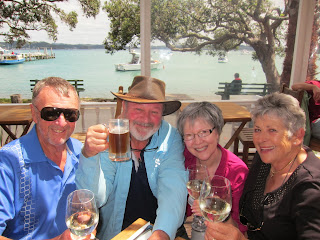 |
| Panoramic view of Mangawhai Heads from the deck at Di & Mi's place |
We spent the next several days with them at their beautiful home in the magnificent Mangawhai Heads. What a strange word, "Mangawhai." Maori tribes are the indigenous peoples of New Zealand, and we later found out that the word Mangawhai (pronounced: man-ga-fy) means "Stream of the Stingray" in the Maori Language.
 |
| From left: Steve, Karen, Torie, and, Di & Mi |
One of the highlights of our visit was meeting relatives we hadn't even known existed: Di's daughter Karen along with husband Steve, and daughter Torie (other daughter Claudia was away at school) and Di's son Kurt along with Krissy and sons Danilo and Oscar (aka the Brandon Brothers).
 |
| Back row (from left): Mi, Di, Krissy, Kurt Front row: Oscar & Danilo |
Karen and Steve entertained us and treated us to "nibbles" and wine in their elegant home in Auckland, and later, we visited with Kurt and his family at a barbecue at Di & Mi's place in Mangawhai Heads. Everyone was so welcoming to "Uncle Frank and Aunty Anne," and we felt very fortunate to meet this whole new side of the family.
 |
| View of the Bay of Islands |
Di & Mi also treated us to a day trip to the spectacular Bay of Islands located on the Auckland Peninsula, about 100 km to the north of Mangawhai Heads.
We rode the car ferry across the bay to the wonderful waterfront town of Russell, NZ:
 |
| Headed for Russell on the ferry |
 |
| On the ferry in the Bay of Islands |
 |
| Exclusive dining here at the Marlborough |
 |
| Cheers to good food, great company, new family members, and a fabulous view! |
It was a holiday weekend in New Zealand, and traffic on the Auckland Peninsula was abundant with vacationers. From the deck of Di and Mi's house, we could see a plethora of holiday seekers congregating in their campers and trailers on the warm beaches of Mangawhai Heads. Of course, the watercraft activity was stepped up with the increased crowd, and we could even see three dolphins frolicking in the waters following behind the pleasure boats, as they cruised in and out of the cove.
One of Mike's volunteer jobs was to help clear and maintain walking trails in and around Mangawhai Heads. On a clear warm day, we hiked up one of these trails to the top of a bluff on Mangawhai Heads for some incredible seascape views:
One of Mike's volunteer jobs was to help clear and maintain walking trails in and around Mangawhai Heads. On a clear warm day, we hiked up one of these trails to the top of a bluff on Mangawhai Heads for some incredible seascape views:
 |
| Hiking the Goldschmidt Track |
 |
| At the top of the bluffs overlooking Mangawhai Heads |
The balls are designed to be played by drop-rolling them using an underhand-style throw across a fine, low-cut, grass court; after release, these heavy, not-exactly-spherical balls curve curiously as they roll slowly towards their target. This curve-action makes it very tricky to control the exact placement of the ball at its destination. In American baseball, it would be the equivalent of throwing a slow but very-pronounced curve ball with every throw, and trying to hit your mark every time. You can do it, but it takes lots of practice! Diane taught us the basics of the game, then turned us loose; we had great fun attempting a few simple moves on the bowling green at Di & Mi's local club (where Di, by the way, is recognized as quite an accomplished player!)
 |
| Frank zeros in on the game of bowls |
 |
| Anne takes a whack at it too |
 |
| Festive and colorful market in downtown Mangawhai |
Di and Mi gave us a great taste of local N.Z. life. They took us to art museums (gorgeous pottery) and a fun weekly market that included live country music along with the handicrafts and fine produce. We also did a wine tasting at the Lochiel Winery Estates and visited the famous Bennett's sweets shop, touted as one of the world's best chocolate shops!
 |
| Fingering the merchandise at Bennett's Chocolate Shop |
Di & Mi also taught us some cool New Zealand expressions. Our favorites: "Don't talk rubbish," "Threw a wobbly" (as in a child throwing a temper tantrum), "I'm buggered" (tired or fed up), "Let's have some nibbles" (let's eat a snack of cheese, crackers, smoked salmon, veggiemite, olives, and piccalily spread), and whatever you do, don't be a stupid, dumb-ass dope about things, otherwise the kiwis will tag you with the dubious title of "Drongo."
But the best part of this visit to Kiwiland was just hanging out
and having good 'ol family fun!
and having good 'ol family fun!
 |
| Hanging with the Kiwis - always fun people!! |
 |
| Anne and Di having a moment |
 |
| Frank even got a ride in Mike's jag! |
That brings us to the end of our South Pacific adventure. What a great trip! Before we go, we want to give one more heartfelt thank you to Di & Mi for the marvelous time we had
in Mangawhai Heads!
in Mangawhai Heads!
 |
| The beauty of Mangawhai Heads, NZ |
 |
| Mi & Di |
















.JPG)

















